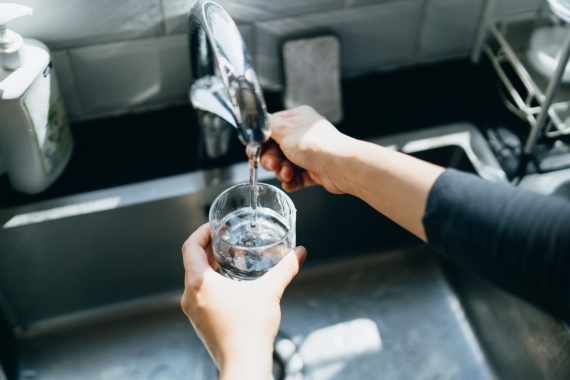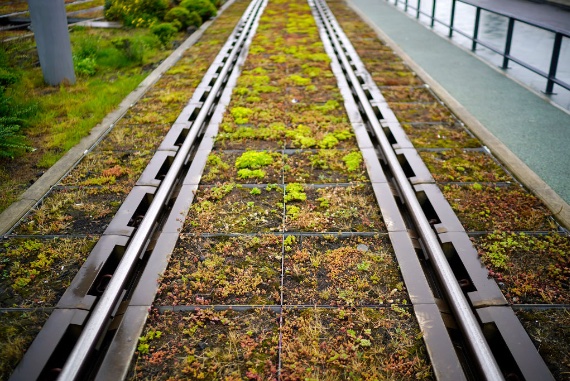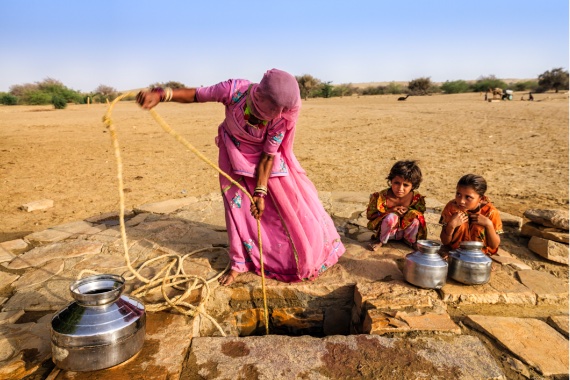The entire world’s water supply fits on a map of the United States, and only 1% of it is accessible for human consumption. Population growth and pollution are increasing water degradation in developing countries, threatening fisheries, agriculture and people’s health. Climate change is intensifying droughts.
Three blue spheres that fit on the map of the United States, and look tiny in the immensity of the globe, graphically show how the total volume of water is miniscule compared to the total volume of the planet. Even the oceans represent only “a thin surface” of H2O. According to this illustration, which is part of the monograph ‘How much water is there on Earth’, published in 2019 by the US Geological Survey (USGS) Water Science School, the largest bubble would be about 1,385 kilometres in diameter—”the distance between Salt Lake City, Utah and Topeka, Kansas”, explains the informative text—and about 1.386 billion cubic kilometres in volume. This would include all the water “in the air as water vapor, in rivers and lakes, in icecaps and glaciers, in the ground as soil moisture and in aquifers, and even in you and your dog,” it adds.
The medium sphere encompasses all liquid freshwater: 272.8 kilometres in diameter and 10,633,450 cubic kilometres between lakes, rivers, swamp water and groundwater; the latter accounts for 99% of the total and is largely inaccessible to humans. The smallest sphere is surface freshwater (lakes and rivers), the main supply for life, with an approximate volume of 93,113 cubic kilometres and a diameter of 56.2 kilometres, according to scientists.
Some 96.5% of the existing water body is saline. Of the remaining 3.5% that is fresh, more than 60% is in the form of ice, at the poles and in glaciers, and another 30% is underground; only 1% of the total is available for human and ecosystem consumption, according to organisations such as the USGS and books such as Water in Crisis: A Guide to the World’s Fresh Water Resources, 1993, with some variation in the percentages. Alberto Garrido, director of the Botin Foundation’s Water Observatory and professor at the Polytechnic University of Madrid, uses this data to raise awareness of the scarcity of a resource that is indispensable for life.
The state of conservation of this vital liquid has improved in the developed world (as Europe demonstrates, despite all its problems), but has worsened in developing countries, “as urban populations grow, material consumption increases and untreated wastewater volumes expand,” according to UNEP, the UN Environment Programme, in its 2016 report ‘A Snapshot of the World’s Water Quality: Towards a global assessment‘.
Smart solutions for water management
According to the UNEP report, severe pathogen pollution already affects around one-third of all river stretches in Latin America, Africa and Asia; severe organic pollution, about one seventh of all river stretches; severe and moderate salinity pollution, about one tenth of all river stretches. Fisheries, agriculture and people’s health are at risk, it warns.

“From our point of view, the solution is not to increase the existing resources, but to manage the ones we have more efficiently, by promoting the use of recycled water for uses not related to human consumption (industry, irrigation, street cleaning), optimising the distribution network to the maximum in order to minimise losses, and raising public awareness of the need to use the resource responsibly,” advocates Canal de Isabel II.
Garrido, for his part, recommends “implementing intelligent network and storage management systems, and increasing the efficiency of urban, industrial, agricultural and livestock use, as well as that of the appliances that use water.” He advocates increasing desalination capacity, wastewater treatment and reclamation, and wastewater reuse, along with strategic management of groundwater resources, in conjunction with surface water.
The OECD points out that agriculture “drinks” about 70% of available water. Coordinating scarcity with preventative adjustments in irrigation allocations (and anticipating cycles of scarcity), and reducing irrigation allocations, where possible, by encouraging crop rotation and improving the technical efficiency of irrigation, are other of Garrido’s recommendations, which he believes should be complemented by measures to improve “the ecological status of water bodies and the chemical and quantitative status of groundwater bodies.”

There are innovations that try to solve derivations of the problem, such as the “fog collectors“ from Aqualonis or the nano-membrane toilet developed by Cranfield University to treat human waste without energy or external water, and which has won the ‘Reinvent the Toilet Challenge‘ competition from the Bill and Melinda Gates Foundation.
The threat of the water crisis
More and more cities (Vancouver is a recent example) are working to develop Sustainable Urban Drainage Systems (SUDS), close to the “Slow Water“ movement and the idea of sponge cities coined by the Chinese landscape architect Yu Kongjian. They seek greater resilience to the effects of climate change not through grey infrastructure—dams, sewers and pipes—but by removing asphalt and leaving more space for the land to soak up and absorb water, helping to refill aquifers and soften runoff.
The Economic Commission for Latin America and the Caribbean (ECLAC) stresses that the region, which holds almost a third of the world’s water resources, has high levels of urban and agricultural water stress, and limited access to safe drinking water: “166 million people still do not have a safely managed service, less than 50% of wastewater is adequately treated and 43% of countries report low levels of integrated water resources management.”

Globally, two billion people do not have access to safe drinking water, according to the new edition of the World Water Development Report, launched ahead of the UN 2023 Water Conference (22-24 March, New York). “At current rates, only 37% of the population of sub-Saharan countries will have safe water by 2030,” it warns.
The study predicts that the world’s thirsty urban population will potentially double from 930 million in 2016 to between 1.7 and 2.4 billion people by 2050. The increasing frequency of extreme and prolonged droughts, a consequence of climate change, will lead to “a global crisis” if no action is taken, warned the report’s editor-in-chief, Richard Connor, in his presentation.
In this vein, an article in the journal Nature shows how the world is facing a water crisis in four powerful charts: on sanitation, on the neglect of Africa, on the intensification of droughts and on faecal contamination. The UN insists that climate change is primarily a water crisis. “We feel its impacts through worsening floods, rising sea levels, shrinking ice fields, wildfires and droughts,” it says.
Comments on this publication